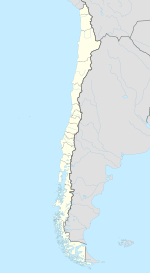Nunoa
| Ñuñoa | ||||||
|---|---|---|---|---|---|---|
| City and Commune | ||||||

Ñuñoa City Hall
|
||||||
|
||||||
| Coordinates (city): 33°27.5′S 70°36′W / 33.4583°S 70.600°WCoordinates: 33°27.5′S 70°36′W / 33.4583°S 70.600°W | ||||||
| Country | Chile | |||||
| Region | Metro Santiago | |||||
| Province | Santiago | |||||
| Government | ||||||
| • Type | Municipal | |||||
| • Mayor | Andrés Zarhi Troy (RN) | |||||
| Area | ||||||
| • Total | 16.9 km2 (6.5 sq mi) | |||||
| Population (2002 Census) | ||||||
| • Total | 163,511 | |||||
| • Density | 9,700/km2 (25,000/sq mi) | |||||
| • Urban | 163,511 | |||||
| • Rural | 0 | |||||
| Residents by gender | ||||||
| • Male | 73,215 | |||||
| • Female | 90,296 | |||||
| Time zone | CLT (UTC-4) | |||||
| • Summer (DST) | CLST (UTC-3) | |||||
| Area code(s) | 56 + | |||||
| Website | Municipality of Ñuñoa | |||||
Ñuñoa (Spanish pronunciation: [ɲuˈɲo.a]; from Mapudungun Ñuñohue, "place of yellow flowers") is a commune of Chile located in the Santiago province and city of Santiago. The oldest municipality in the traditional east end of Santiago, Ñuñoa has most city amenities (subways, banks, shopping areas, etc.) while still maintaining its character as a quiet, residential area.
Recently, Ñuñoa's many charms and convenient location have led to an increased desire by young urban professionals to live there. In response, developers have bought out older homes and erected multi-dwelling units, a practice that has triggered much criticism from long-time residents. In 2007, Ñuñoa was cited for the third consecutive year as the district with the highest quality of life in Santiago.
Ñuñoa boasts bustling public services and private businesses and a public transportation system serving all parts of the municipality. Most business activity takes place along Irarrázaval Ave., a 6-km thoroughfare crossing the entire municipality east-west. Ñuñoa is also home to Santiago’s only mosque and to the National Stadium, Chile’s largest sports complex. During the military dictatorship headed by Augusto Pinochet, the National Stadium, which stands in the heart of Ñuñoa, was turned into a notorious torture and death camp where tens of thousands were held. Every September 11, on the anniversary of the coup d'état that brought Pinochet to power, a candlelight vigil is held in remembrance of the scores of Chileans and people of many nationalities who were imprisoned, tortured and killed in the Stadium at the hands of their military captors.
Per the 2002 census of the National Statistics Institute, Ñuñoa spans an area 16.9 km2 (7 sq mi) in size and has 163,511 residents (73,215 male and 90,296 female), making it a wholly urban area. The population dropped 5.3% (9,064 residents) from the 1992 to the 2002 censuses. The 2009 population was projected to be 149,205.
...
Wikipedia




